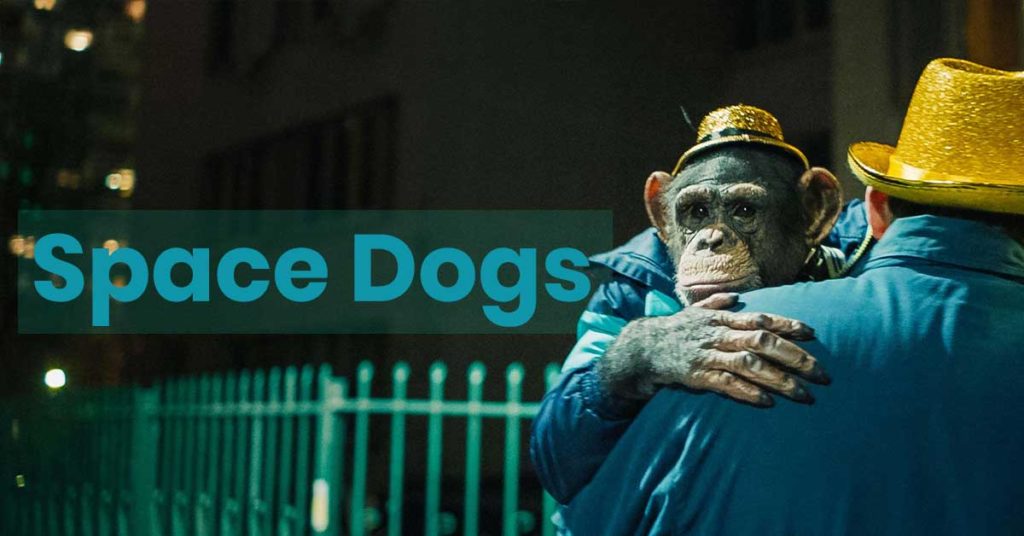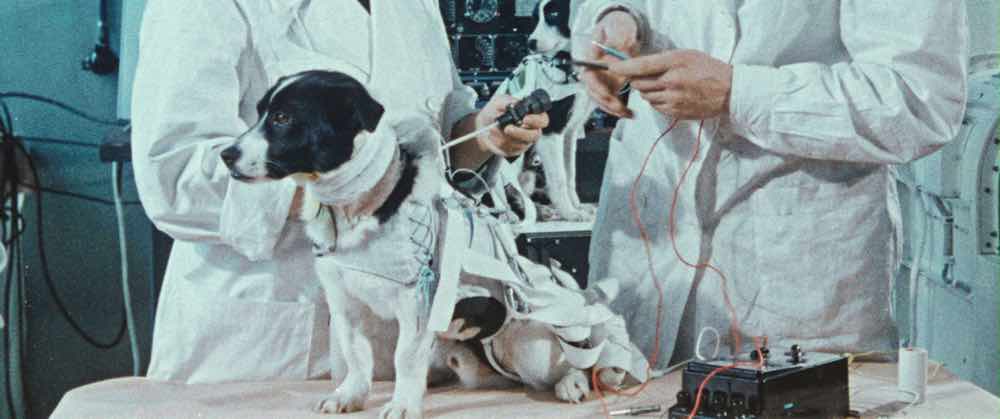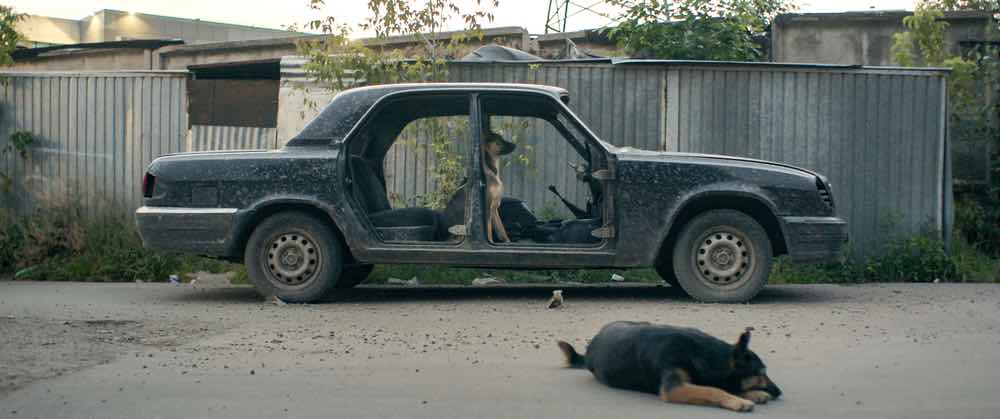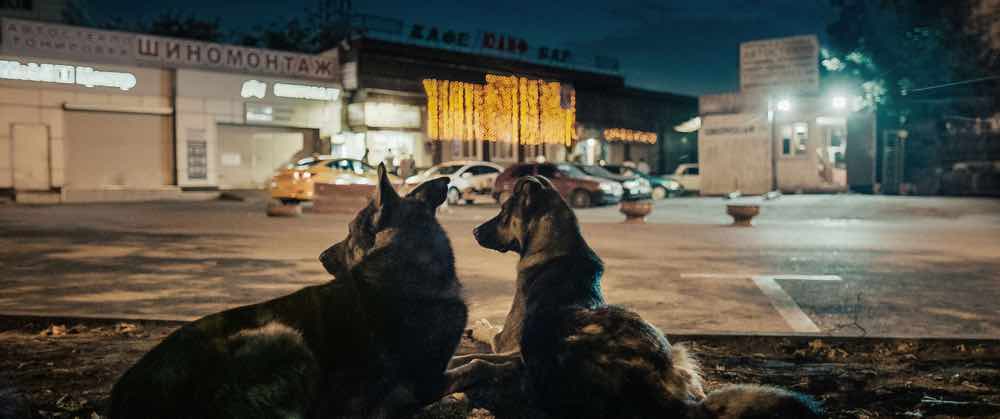Directors Elsa Kremser and Levin Peter discuss their Locarno documentary Space Dogs, about today’s Moscow street dogs and those of the past that were sent into space.

Following a handful of street dogs in the streets of contemporary Moscow, Space Dogs shows us the structure of the lives of animals we usually barely glance at. They have friends, favourite spots, fights — but they’re not human. As directors Elsa Kremser and Levin Peter follow the pack, our tendency to anthropomorphise the animals is repeatedly challenged: cute one moment, they can be cruel and violent the next. Though we can empathise with their plight (they never lack food, but their lives are far from easy), we are also forced to accept the fact that there is a whole dimension to dogs’ lives that has nothing to do with us humans.
This deconstruction of the anthropocentric gaze — that which puts humans at the centre of the world, with everything else being less important — is heightened by the inclusion of one of the most extreme examples of said anthropocentrism: the “space dogs” of the title. Through archival footage, the film contrasts the freedom of contemporary street dogs with the fate of their ancestors, picked up from the same Moscow streets some fifty years ago and sent to space for the sake of human curiosity.
The images, recorded by the scientists themselves as part of their experiments, show these animals — including Laika, the first dog ever sent to space — be operated on, put in tiny boxes, then thrown into the unknown. It is a tough watch, yet we keep watching, spurred on by a strange and soothing Russian voiceover narration that runs throughout the film. Like a sort of Soviet astronaut turned poet, the disembodied voice continually raises questions about what these animals might be seeing, understanding, or feeling up there in space and down here in our streets.
At the Locarno Film Festival, where the film premiered in the Filmmakers of the Present section, we discussed the film’s anti-anthropocentric gaze with directing duo Elsa Kremser and Levin Peter.
Seventh Row (7R): How did the project Space Dogs start?
Elsa Kremser: We wanted to make a film about a pack of dogs, because we were interested in their perspective and in their world. Then very early on, during research, we found out that Laika used to on the streets of Moscow. We made this connection between space and the street, and the contradictions in that. We also wanted to address the human influence. In a way, space travel is a symbol of the highest possible influence of humans on animals.
Levin Peter: And we were searching for a layer, a frame that we could put around our heroes, the main dogs. Then suddenly, when we found out that Laika had been living on the streets, the film became so rich. These street dogs we see in the film are real explorers. They have to be in order to survive. They have to understand every movement in the city. They have to know how the city is changing and how they can find a place to stay and survive. We found it interesting that there were similarities between these dogs and their ancestors, the heroic cosmonaut dogs.
7R: So, despite the title, the film didn’t start as a space movie?
Levin Peter: Not at all.
7R: How did you integrate the idea of the space mission into the film? There are whole stretches where we just stay with the street dogs, and then long stretches about the space missions, as well. How did you work out the balance between the two?
Elsa Kremser: It was a long process in the editing. We recognised that, as soon as the space story got too big, the viewer lost the ability to perceive the dogs, which was our main goal. So we made a version without any of the space footage; it was just the dogs on the streets. It was very nice to watch! And that was a crucial point of our process working out how to tell the story of the dogs on the streets. Then, we integrated the space story piece by piece, very carefully.

7R: How did you manage to follow these dogs on the streets so closely and without them really noticing you?
Levin Peter: The look of the film was one of the first things we were really sure about. The idea of being at dog level wasn’t ever a question; it just came with the concept for the film. Finding out how to actually shoot that was a long, sometimes nerve-wracking process, because we had to try so many different things. There were no references on how to do it. We found a lot of visual references in films, but not technical examples of how to achieve that. We were not inspired by those BBC nature documentaries because they look so different from what we wanted to do.
In the end, after we tried different set-ups, most of them too heavy, we invented a light camera with a handle. On the handle, our DoP [Director of Photography] Yunus Roy Imer was able to control the focus. It was a one-hand thing, which was maybe the most challenging aspect of the shoot for him. He had to do it all with one handle — not with two as is usual with an eye-level camera. All in all, it was two months of trying, and we recorded all those trials; then, we threw them away. What you see in the film are just the last five weeks of shooting out of twelve.
We still wonder if the dogs understood what we were doing with them. It’s so obvious to us that they have an understanding of our attention, that we really created something with them. One time, they stopped to look at the camera. They weren’t disturbed by us.
Camera rig inventions in Evelyn
To make the documentary Evelyn, the cinematographer also had to invent a camera rig to capture the footage they needed. Elena Lazic talked to the DP about how he did this.
Elsa Kremser: They were somehow conscious of the lens. One dog in particular would let us come close to him with the camera, but as soon as the lens was pointing at him, he would go away. We’d put a blanket on the camera, and we could even touch him when it was pointing away, but as soon as we moved it towards him, he would go away. We think maybe all those dogs were conscious of the lens, because you can also interpret it as an eye.
Levin Peter: The younger dog, the main one in the film, really is a searching one. He’s so young, so cheerful; he doesn’t know too much about life and the city. As soon as we saw him, Elsa said we should concentrate on him, because she knows much more about dogs than I do. And I think it was right to believe in his will to spend time with us, to explore things with us.

7R: There is this very upsetting scene in the film where the lead dog suddenly grabs and kills a cat. Did you have conversations about whether to include this footage, which makes the dogs appear in a rather less cute and less sympathetic light?
Elsa Kremser The question about whether dogs are just cute and just there for us is what moved us to make this film and to tell this story. With the cat scene, it was happening to us, too. We were following them, and then this happened. Of course, we didn’t have the time to think; we just continued to do what we’d always been doing, filming them whether they were jumping on the car, killing the cat, or just eating a bone on the floor.
But of course, it was shocking for us, too, and a very crucial point in the development of the film; they somehow took away the control from us. We had expectations of what they would do, of what would happen or what should happen. But in that scene, we understood that we had shot something that was important for them, where we just followed.
There was never a doubt about including it in the film; it was clear to us that it was very important. For a young dog to kill for the first time, I think it’s important. It’s about his life, even if he doesn’t need to eat the cat; there’s cat food from old ladies all over Moscow, and he’s not hungry. But he has this natural thing.
7R: The structure of the film is quite loose and unpredictable. How did you organise it, with the narration, as well?
Elsa Kremser: This, we also figured out with the scene of the cat being killed, in particular. If you made that scene short, to just show that this thing did happen, then it told the story in a more human-centric way and felt more exploitative. If the scene was short, this shocking moment would feel like it was included just to show that, “Wow, they managed to catch that.”
Instead, we let it go on. We wanted to create a space where you could think about why the dogs did that, but also ask yourself, Why am I reacting the way I do? This was what we asked ourselves while we shot the scene. Why am I sad? Why am I angry at this dog? What is my human perception of this?
Levin Peter: In the editing room, we were concentrating on real character building. As former film students, everyone learns in the first few years how to write a fictional screenplay, which helped a lot. We were mostly inspired by fiction films for that.
The subject came up again with the cat scene, when we had to decide if it was part of the process where you build up your characters, or if it would be a conclusion. Is it something the whole film leads to? If the cat scene came on too late in the film, then it wasn’t clear that the dogs were the main protagonists. We realised that even though this scene is such a challenge to watch, if you overcome that challenge, you really understand that the two dogs in the scene are the main characters who will lead the film their own way. That was very important.
The position of that scene also changed the perception of the tension between the two dogs. When we put the cat scene earlier on in the film, it became much more interesting to follow the tension between them and their relationship. Everything became richer.

7R: The ending of the film, centred on a little group of puppies who we see grow up then die from poisoning, is also very powerful and quite shocking. How did that scene come about?
Elsa Kremser: We spent some weeks with them: watching how they were growing up, how they were starting to explore their environment. One day, we came up there, and they were sick. We tried to save them; we brought one to the vet, but he died. Only one puppy survived.
For quite a long time in the editing process, we had a much happier ending where you just saw this new generation rising. We had cut out the dying part because we thought it would be too tough on the audience. We thought, Do we really want to end the film with this really frustrating thing where a human kills again, poisoning the animals? But then we watched it several times, and thought, Can we really hide what truly happened just for human viewers to be happier after the film?
Levin Peter: I remember that we had lots of scenes in mind before we shot. We were really prepared with lots of possible events. We wanted to film a birth! It was maybe a little sentimental, this idea that we would end the film with a dog giving birth. And we went searching for this thing that was almost impossible to find and almost impossible to shoot: dogs really hide to give birth.
7R: Did you know you wanted a narrator from the beginning of the project?
Elsa Kremser: Yes. But we had this moment of doubt: should a human voice narrate this film? At the very beginning of the project, we thought no one should be talking; “Humans are not important!” was our credo.
But this narration we have is some sort of cosmic voice. Maybe it isn’t even human. We also had these diaries from the scientists who were involved in the [space] program; the language they used was so poetic and so cruel at the same time. A lot of the words and expressions we used in the narration come from those diaries.
Finding out whether each word fit well with the emotions took time. But while shooting, we also had a lot of ideas for the narration. There are quite a few shots in the film that were made specifically for the narration.
Levin Peter: The main part of that work [on developing the narration] came during the editing. It wasn’t easy because, as the film took shape, the possibilities for the narration became more and more limited. It was easier to write it when there was much more stuff in the film.
7R: I am no expert, and I have no idea whether these experiments done on animals were actually useful from a scientific point of view. But at the end of the film, they just feel cruel. Do you feel that nothing could ever justify this cruelty?
Levin Peter: No. We tried to include scientific explanation of what these experiments were for, but it just didn’t work with the film. Because, as Elsa said, as soon as this cosmic, God-like voice was giving us information to satisfy our need for reassuring explanations, the whole film fell apart, and the character of the narrator was not as strong as it is now. The scientists found very interesting ways to describe the aim of their experiments and why it was important to sacrifice these animals, but having explanations about why exactly they were doing those things just didn’t work.
Elsa Kremser: Truth itself was a big subject of discussion throughout the making of the film — what is true, what really happened, why did they do this, and why do we humans want to explore space. We discussed this a lot, but there never was a really satisfactory answer.
Of course, I’m fascinated with space, and I’m somehow glad that science is exploring the universe. But why do we really want to go to space? I think this is something every human being has to answer for themselves.
Levin Peter: We also wondered, Is it really our human will to go to space? It is always claimed that “man” wants to go to space: “man” wants this; “man” wants that. But I don’t actually know many people who want to go there. Is it just sold to us as a collective goal? This fascination for eternity, for space and time — it’s there. But was there really a mass movement in the 1950s saying, “We have to go”?
Elsa Kremser: We were also thinking the human being really isn’t wanted in space. The human being can’t live in space. It sometimes feels the same for the dogs’ world, because we’re also strangers there.
These are two spaces where we don’t belong, but we want to have them under our control. We want to understand everything out there so that we can say, “Ah, this is how it works. We now rule this world.” We rule space so that, in case something comes down from there, we can blow it up.

